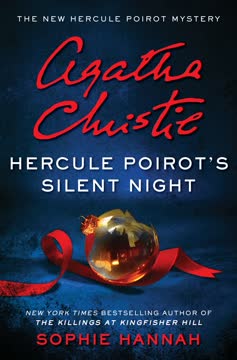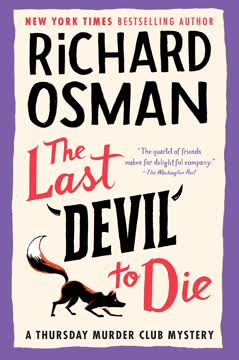Plot Summary
Christmas Plans Disrupted
Poirot and his friend, Inspector Catchpool, are looking forward to a peaceful Christmas in London. Their plans are interrupted by the unexpected arrival of Catchpool's mother, Cynthia, who insists they accompany her to Norfolk. She claims her friend Vivienne Laurier is in distress after a murder at the local hospital, and only Poirot can help. Reluctantly, the pair agree, setting the stage for a holiday far more eventful—and dangerous—than they anticipated.
The Norfolk Invitation
Cynthia reveals the murder of Stanley Niven, a beloved patient at St. Walstan's Hospital, has left her friend Vivienne in a state of terror. Vivienne's husband, Arnold Laurier, is terminally ill and due to move into the very ward where Niven was killed. Vivienne fears Arnold will be the next victim. Cynthia's emotional manipulation and Poirot's curiosity about the "jolly" nature of the victim draw the detective and Catchpool to the windswept Norfolk coast, where family secrets and local tensions simmer beneath the surface.
Arrival at Frellingsloe House
The travelers are greeted by a cast of eccentric and troubled residents at Frellingsloe House: the dying Arnold, his anxious wife Vivienne, their two sons and daughters-in-law (who are also sisters), the Surtees in-laws, and two lodgers—a doctor and a curate. The house itself is threatened by coastal erosion, mirroring the instability within. Poirot senses underlying tensions, rivalries, and resentments, as well as a pervasive sense of dread, especially surrounding Arnold's impending move to the hospital.
The Unsolved Hospital Murder
Stanley Niven, universally liked and known for his cheerfulness, was killed in his private hospital room. The local police, led by the bumbling Inspector Mackle, suspect Niven's family, but all have solid alibis. Poirot learns that on the day of the murder, the Laurier family (except Arnold) and a nurse were in the room next door, supposedly with the door closed the entire time. A mysterious patient, Professor Burnett ("Mr. Hurt-His-Head"), may have witnessed the crime, but his mental state renders his testimony cryptic and unreliable.
Family Tensions and Secrets
As Poirot and Catchpool settle in, they observe the Laurier and Surtees families' complicated dynamics. The two Laurier sons are married to the Surtees sisters, but the sisters' relationship is fraught with jealousy and bitterness. The Surtees parents, now serving as cook and gardener, feel diminished and resentful. Arnold's enthusiasm for solving the murder himself is both a source of hope and anxiety, especially for Vivienne, whose fear for her husband's safety seems to go beyond rational explanation.
Arnold's Deadly Enthusiasm
Arnold, despite his illness, is animated by the prospect of playing detective at St. Walstan's. He idolizes Poirot and wants to solve Niven's murder himself, seeing it as a final adventure. Vivienne, however, is desperate to keep him away from the hospital, convinced he will be the next victim. Poirot is struck by the similarity between Arnold and Niven: both are "happy men," beloved by all, and both seem to attract misfortune. The question of motive—why kill such men?—haunts Poirot.
The Jolly Victims
Poirot's interest is piqued by the fact that both murder victims are described as irrepressibly cheerful, spreading joy to those around them. He wonders if this trait is the key to the case. Meanwhile, the investigation uncovers two leads: a woman who irrationally blamed Niven for her troubles at the post office, and the enigmatic Mr. Hurt-His-Head, who may have witnessed the murder but can only repeat the phrase "to hurt his head." The possibility of a killer targeting "happy men" emerges, but the motive remains elusive.
The Locked Room Puzzle
The murder of Stanley Niven appears to be a classic locked-room mystery. The Laurier family and nurse claim to have been together in the adjacent room with the door closed, while doctors and nurses were in the corridor. No one saw anyone enter or leave Niven's room. Poirot suspects that the truth lies in the details of who was where, and when, and that someone's account is not entirely honest. The hospital's layout, the timing, and the movements of the various parties become central to unraveling the puzzle.
Christmas Trees and Confessions
As Catchpool is conscripted into decorating Christmas trees, he uses the opportunity to gather information from the household. Family members reveal grudges, disappointments, and secret hopes. The Surteeses lament their daughters' estrangement; the Laurier sons and their wives bicker over inheritance and loyalty. The curate and the doctor are both entangled emotionally with Vivienne. Underneath the festive preparations, the sense of impending tragedy grows, and Poirot's unease deepens.
The Poisoning of Poirot
Poirot falls violently ill and is hospitalized at St. Walstan's. It is revealed that Cynthia, Catchpool's mother, poisoned him—not to harm, but to ensure he would be admitted as a patient and could investigate the hospital from within, believing this would help him solve the case. Poirot, though furious, uses his time in the hospital to observe the staff and patients, including Mr. Hurt-His-Head, and to piece together the psychological landscape of the crime.
The Second Murder Strikes
Just as Poirot recovers, Arnold Laurier is found murdered in his study, killed in the same manner as Niven—with a blow to the head from a vase. The scene is staged to mimic the hospital murder, but Poirot quickly notices discrepancies: the vase, the flowers, and the water are all deliberate references, not organic details. The window is broken from the inside to suggest an intruder, but Poirot deduces the killer is someone within the house. The family is thrown into chaos, and suspicion falls on everyone.
The Truth About Vivienne
Poirot's investigation uncovers that Vivienne Laurier is not who she claims to be. She is, in fact, Iris Haskins, the long-lost sister of Nurse Bee Haskins. Years ago, Iris betrayed her sister, leading to tragedy and her own self-imposed exile. She reinvented herself as Vivienne, marrying Arnold and building a new life. The return of Bee Haskins to the area, and the chance of being recognized, drove Vivienne to desperation. The murders were not acts of hatred, but of self-preservation—killing to prevent her past from being exposed.
The Sister's Secret
Vivienne's (Iris's) letter reveals her psychological torment. She believed she had truly become a new person, leaving Iris and her guilt behind. The prospect of Bee recognizing her threatened to destroy her identity as Vivienne. The murder of Niven was a panicked act to avoid Bee; Arnold's murder was to prevent the impossible choice between revealing her secret or abandoning her dying husband. The family's happiness, the web of lies, and the tragic consequences all stem from this buried secret.
The Motive Unveiled
Poirot explains that the motive was not to keep a secret from others, but to avoid being forced to become Iris again—to face herself as the person who had caused so much pain. The murders were acts of psychological self-defense, not malice. Vivienne's terror was not of exposure, but of annihilation—the loss of her new, better self. The "happy men" were collateral damage in her struggle to maintain her identity. The case is solved not by physical clues, but by understanding the human heart.
The Final Confrontation
Vivienne is confronted by Bee and the family. The revelation devastates the household, but also brings a strange sense of closure. Bee forgives her sister, recognizing the suffering that led to her actions. The family, shattered by loss and betrayal, must find a way to move forward. Poirot and Catchpool, exhausted and changed by the experience, return to London, reflecting on the nature of guilt, identity, and the limits of justice.
Letters and Legacies
Catchpool receives a letter from Vivienne, written after her arrest. She insists that "Vivienne" did not commit the murders—only Iris, the person she once was. She accepts responsibility, but pleads for understanding: her crimes were the desperate acts of someone trying to escape her own past. The letter forces Catchpool and Poirot to confront the ambiguity of identity and the complexity of moral judgment.
Christmas Aftermath
Poirot and Catchpool spend Christmas in London, haunted by the events in Norfolk. They reflect on the case, the pain of families, and the impossibility of ever fully escaping one's past. The Morality Game, once a trivial holiday diversion, now seems darkly ironic. The story ends with a sense of melancholy, but also of hard-won wisdom: the truth, however painful, is the only path to freedom.
The Nature of Guilt
In the aftermath, Poirot and Catchpool debate the true motive for the murders. Was it fear of exposure, or the deeper fear of becoming again the person one cannot bear to be? The case becomes a meditation on guilt, forgiveness, and the possibility of redemption. The final lesson is that justice is not always about punishment, but about understanding—and that sometimes, the greatest crime is the refusal to face oneself.
Characters
Hercule Poirot
Poirot is the legendary Belgian sleuth whose "little grey cells" unravel the most baffling mysteries. In this case, he is drawn into a web of family secrets, psychological trauma, and moral ambiguity. Poirot's methodical approach, attention to detail, and deep empathy allow him to see beyond surface appearances. He is fascinated by the emotional lives of his suspects, especially the paradox of "happy men" becoming murder victims. Poirot's own vulnerability—his poisoning and subsequent illness—adds a layer of humanity, as he confronts not only the puzzle but the pain and complexity of the human heart.
Inspector Edward Catchpool
Catchpool is Poirot's friend and chronicler, a Scotland Yard inspector with a complicated relationship to his overbearing mother. He serves as the reader's surrogate, navigating the labyrinth of family dynamics and personal guilt. Catchpool's psychological insight, empathy, and occasional self-doubt make him a sensitive observer. His journey is one of growth: from reluctant participant to active investigator, and finally to a man forced to confront the nature of guilt, forgiveness, and the limits of justice.
Vivienne Laurier / Iris Haskins
Vivienne is the wife of Arnold Laurier, outwardly devoted and loving, but inwardly tormented by a secret past. She is, in fact, Iris Haskins, who betrayed her sister Bee years ago, leading to tragedy and her own self-exile. Vivienne's psychological struggle is the heart of the novel: she has reinvented herself, but the return of her sister threatens to destroy her new identity. Her fear, desperation, and eventual crimes are driven not by malice, but by the terror of becoming again the person she cannot bear to be. Her letter reveals a profound split between "Iris" and "Vivienne," raising questions about identity, responsibility, and redemption.
Arnold Laurier
Arnold is a man facing death with enthusiasm and humor, determined to solve a murder as his final adventure. His optimism and love for his family make him beloved, but also blind to the pain and secrets around him. Arnold's desire to play detective, his idolization of Poirot, and his refusal to accept the reality of his illness and the house's impending destruction all contribute to the tragedy. His murder is both a personal and symbolic loss—the end of joy in a family consumed by secrets.
Cynthia Catchpool
Cynthia is Catchpool's mother, whose determination to involve Poirot in the Norfolk case sets the story in motion. Her actions—especially poisoning Poirot to force his hospitalization—are both comic and disturbing, revealing her inability to respect boundaries or consider consequences. Cynthia's psychological need for control, her desire to be needed, and her blindness to the pain she causes make her a complex figure. She embodies the theme of good intentions gone awry, and the dangers of meddling in others' lives.
Bee Haskins
Bee is Vivienne's (Iris's) estranged sister, a nurse at St. Walstan's, and the mother of Zillah Hunt. Betrayed by Iris years ago, Bee has rebuilt her life, but the return of her sister reopens old wounds. Her compassion, strength, and eventual forgiveness are central to the novel's emotional resolution. Bee's presence is both a threat and a salvation for Vivienne, forcing a reckoning with the past and offering the possibility of grace.
Douglas and Jonathan Laurier
Arnold and Vivienne's sons, Douglas and Jonathan, are married to the Surtees sisters, Maddie and Janet. Their relationship is marked by rivalry, resentment, and conflicting loyalties. Douglas is rakish and irreverent; Jonathan is earnest and self-righteous. Their wives' feud mirrors their own, and their responses to their father's death reveal the corrosive effects of family secrets and unspoken grievances.
Maddie and Janet Laurier
The Surtees sisters, married to the Laurier brothers, are locked in a bitter feud that poisons the household. Maddie is outspoken and passionate; Janet is sensitive and wounded. Their estrangement is rooted in jealousy, perceived betrayal, and the pain of unmet expectations. The trauma of Arnold's murder ultimately brings them back together, suggesting the possibility of healing even in the aftermath of tragedy.
Enid and Terence Surtees
The Surtees parents, now serving as cook and gardener at Frellingsloe House, feel diminished and unappreciated. Enid's longing for her daughters' reconciliation and for grandchildren is a source of both hope and bitterness. Terence's regret over past decisions and his resentment toward Arnold reflect the novel's themes of displacement, loss, and the search for belonging.
Dr. Robert Osgood and Felix Rawcliffe
Dr. Osgood, Arnold's physician and a lodger, is secretly in love with Vivienne, while engaged to Nurse Olga Woodruff. His divided loyalties and emotional confusion add to the household's instability. Felix Rawcliffe, the curate, is also emotionally involved with Vivienne, though more as a surrogate son than a lover. Both men are outsiders, observers, and potential suspects, their presence highlighting the blurred boundaries between family, duty, and desire.
Plot Devices
Locked-Room Mystery and Alibi Manipulation
The murder of Stanley Niven is presented as an impossible crime: a locked-room mystery with all suspects apparently accounted for. The narrative structure relies on shifting perspectives, unreliable memories, and the manipulation of alibis. Poirot's methodical questioning, attention to timing, and focus on the psychological states of the suspects gradually reveal the truth. The use of the hospital's layout, the timing of movements, and the ambiguity of who was where and when are central to the unraveling of the mystery.
Doppelgänger and Identity Concealment
The central plot device is the revelation that Vivienne Laurier is, in fact, Iris Haskins, living under an assumed identity. This device allows for the exploration of themes of guilt, reinvention, and the impossibility of escaping one's past. The doppelgänger motif is reinforced by the physical resemblance between Vivienne and Bee, and by the psychological split between "Iris" and "Vivienne." The fear of recognition, the desire to become someone new, and the lengths to which one will go to preserve a fragile identity drive the plot and provide the emotional core of the story.
Foreshadowing and Symbolism
The novel uses foreshadowing through repeated references to "happy men," the impending destruction of Frellingsloe House, and the unresolved tensions within the family. The Christmas trees, the Morality Game, and the coastal erosion all serve as symbols of impermanence, the fragility of happiness, and the destructive power of secrets. The poisoning of Poirot, the cryptic utterances of Mr. Hurt-His-Head, and the staged similarities between the two murders all foreshadow the ultimate revelation.
Psychological Motive and Split Identity
The most significant plot device is the psychological motive: the murders are not committed out of hatred or greed, but out of the desperate need to preserve a new, better self. The split between "Iris" and "Vivienne" is both literal and metaphorical, raising questions about responsibility, guilt, and the possibility of redemption. The narrative structure, with its shifting perspectives, letters, and confessions, mirrors the fragmentation of identity at the heart of the story.
Analysis
Hercule Poirot's Silent Night is a masterful reimagining of the classic country house murder, infused with psychological depth and modern sensibility. At its core, the novel is less about the mechanics of crime than about the complexities of identity, guilt, and the human need for reinvention. The locked-room puzzle and the parade of suspects provide the familiar pleasures of the genre, but the true mystery lies within the heart of Vivienne Laurier/Iris Haskins. Her desperate attempt to escape her past, and the tragic consequences that follow, transform the story into a meditation on the nature of selfhood and the impossibility of true erasure. The novel interrogates the limits of justice: is punishment enough, or is understanding—and perhaps forgiveness—more important? The interplay between happiness and suffering, the corrosive effects of secrets, and the redemptive power of truth are woven throughout. Poirot's compassion, Catchpool's empathy, and the ultimate confrontation between sisters offer a vision of justice that is both humane and unsparing. In the end, the lesson is clear: we cannot outrun our past, but we can, through honesty and courage, find a measure of peace. The book stands as a testament to the enduring power of the detective story to illuminate the darkest corners of the human soul.
Last updated:
Review Summary
Hercule Poirot's Silent Night receives mixed reviews. Some readers appreciate Hannah's ability to capture Christie's style and Poirot's essence, praising the intriguing mystery and festive atmosphere. Others criticize the plot as nonsensical, characters as grating, and Poirot as a pale imitation. Many find the pacing slow and the resolution unsatisfying. Some fans enjoy the continuation of Poirot's adventures, while others prefer the original Christie works. The book's Christmas setting and classic mystery elements appeal to some, but others feel it lacks the charm and cleverness of Christie's originals.
Similar Books
Download PDF
Download EPUB
.epub digital book format is ideal for reading ebooks on phones, tablets, and e-readers.









